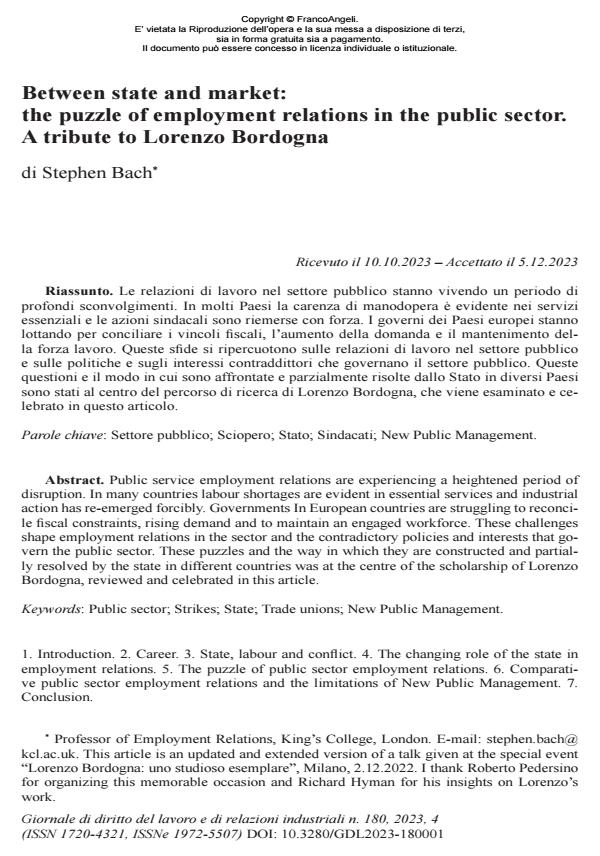Between state and market: the puzzle of employment relations in the public sector. A tribute to Lorenzo Bordogna
Titolo Rivista GIORNALE DI DIRITTO DEL LAVORO E DI RELAZIONI INDUSTRIALI
Autori/Curatori Stephen Bach
Anno di pubblicazione 2024 Fascicolo 2023/180
Lingua Inglese Numero pagine 12 P. 513-524 Dimensione file 634 KB
DOI 10.3280/GDL2023-180001
Il DOI è il codice a barre della proprietà intellettuale: per saperne di più
clicca qui
Qui sotto puoi vedere in anteprima la prima pagina di questo articolo.
Se questo articolo ti interessa, lo puoi acquistare (e scaricare in formato pdf) seguendo le facili indicazioni per acquistare il download credit. Acquista Download Credits per scaricare questo Articolo in formato PDF

FrancoAngeli è membro della Publishers International Linking Association, Inc (PILA)associazione indipendente e non profit per facilitare (attraverso i servizi tecnologici implementati da CrossRef.org) l’accesso degli studiosi ai contenuti digitali nelle pubblicazioni professionali e scientifiche
Public service employment relations are experiencing a heightened period of disruption. In many countries labour shortages are evident in essential services and industrial action has re-emerged forcibly. Governments In European countries are struggling to reconcile fiscal constraints, rising demand and to maintain an engaged workforce. These challenges shape employment relations in the sector and the contradictory policies and interests that govern the public sector. These puzzles and the way in which they are constructed and partially resolved by the state in different countries was at the centre of the scholarship of Lorenzo Bordogna, reviewed and celebrated in this article.
Le relazioni di lavoro nel settore pubblico stanno vivendo un periodo di profondi sconvolgimenti. In molti Paesi la carenza di manodopera è evidente nei servizi essenziali e le azioni sindacali sono riemerse con forza. I governi dei Paesi europei stanno lottando per conciliare i vincoli fiscali, l’aumento della domanda e il mantenimento della forza lavoro. Queste sfide si ripercuotono sulle relazioni di lavoro nel settore pubblico e sulle politiche e sugli interessi contraddittori che governano il settore pubblico. Queste questioni e il modo in cui sono affrontate e parzialmente risolte dallo Stato in diversi Paesi sono stati al centro del percorso di ricerca di Lorenzo Bordogna, che viene esaminato e celebrato in questo articolo.
Parole chiave:Parole chiave: Settore pubblico; Sciopero; Stato; Sindacati; New Public Management
- Accornero A. (1985). The Tertiarization of Labour Disputes and its Effects. In: Cella G.P., Regini M., a cura di, Il conflitto industriale in Italia. Bologna: il Mulino.
- Bach S., Bordogna, L. (2011). Varieties of new public management or alternative models? The reform of public service employment relations in industrialized democracies. IJHRM, 22(11): 2281 ss.
- Bach S., Bordogna L. (2013). Reframing public service employment relations: The impact of economic crisis and the new EU governance. EJIR, 19(4).
- Bach S., Bordogna, L. (2016). Emerging from the Crisis. The Transformation of Public Service Employment Relations. In: Bach S., Bordogna L., Public Service Management and Employment Relations in Europe. New York: Routledge.
- Bach S., Bordogna L., Della Rocca G., Winchester D., eds. (1999). Public Service Employment Relations in Europe. London: Routledge.
- Bordogna L. (1989). The COBAS fragmentation of trade-union representation and conflict. IP, 3(50-65).
- Bordogna L. (1999). Italy: A case of co-ordinated decentralization. In: Bach S., Bordogna L., Della Rocca G., Winchester D., Public Service Employment Relations in Europe. London: Routledge.
- Bordogna L. (2007). Industrial Relations in the Public Sector. Dublin: European Foundation for the Improvement of Living and Working Conditions.
- Bordogna L. (2008a). Dispute Resolution in Essential Public Services in Italy: Strengths and Weaknesses of a “Pluralist Approach”. JIR, 50(4).
- Bordogna L. (2008b). Moral Hazard, Transaction Costs and the Reform of Public Service Employment Relations. EJIR, 14(4): 381 ss.
- Bordogna L., Cella G.P. (1999). Admission, exclusion and correction: the changing role of the state. Transfer, 1-2: 14 ss.
- Eisenhardt K. (1989). Agency Theory: An Assessment and Review. AMR, 14(1): 57 ss. Hyman R. (2009). Why Industrial Relations. In: Aa.Vv., What’s the Point of Industrial Relations? In defence of Critical Social Science. London: BUIRA.
- Jackall R. (1988). Moral Mazes: The World of Corporate Managers. Oxford: Oxford University Press.
- Olson M. (1965). The Logic of Collective Action: Public Goods and the Theory of Groups. Boston: Harvard University Press.
- Pollitt C. (2001). Convergence: The Useful Myth? PA, 79(4): 933 ss.
- Wellington, Winter, R. (1971). The Unions and the Cities: Studies of Unionism in Government. Washington: Brookings Institute.
- Williamson O. (1975). Markets and Hierarchies: Analysis and Anti-Trust Implications. New York: Free Press.
Stephen Bach, Between state and market: the puzzle of employment relations in the public sector. A tribute to Lorenzo Bordogna in "GIORNALE DI DIRITTO DEL LAVORO E DI RELAZIONI INDUSTRIALI " 180/2023, pp 513-524, DOI: 10.3280/GDL2023-180001